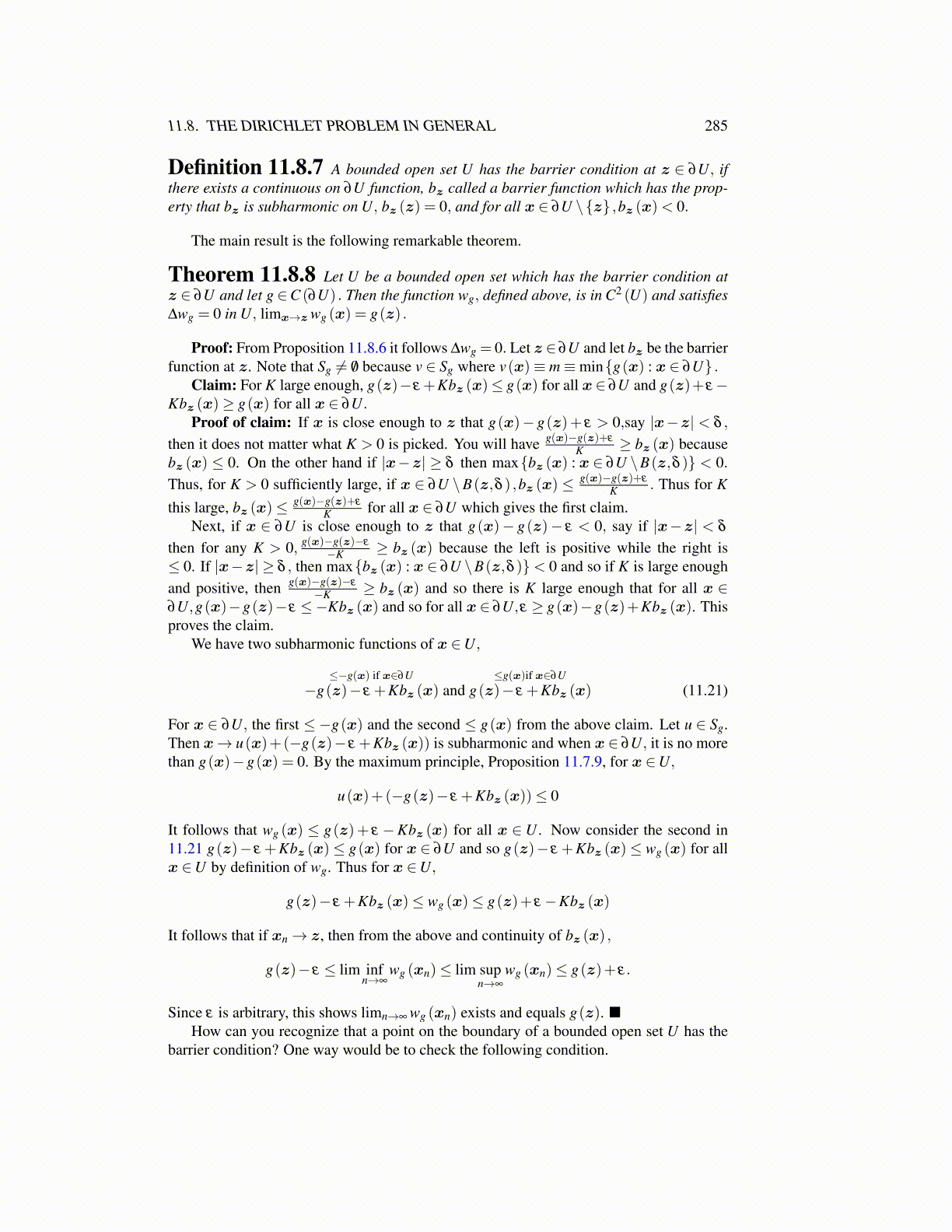
11.8. THE DIRICHLET PROBLEM IN GENERAL 285
Definition 11.8.7 A bounded open set U has the barrier condition at z ∈ ∂U, ifthere exists a continuous on ∂U function, bz called a barrier function which has the prop-erty that bz is subharmonic on U, bz (z) = 0, and for all x ∈ ∂U \{z} ,bz (x)< 0.
The main result is the following remarkable theorem.
Theorem 11.8.8 Let U be a bounded open set which has the barrier condition atz ∈ ∂U and let g ∈C (∂U) . Then the function wg, defined above, is in C2 (U) and satisfies∆wg = 0 in U, limx→z wg (x) = g(z) .
Proof: From Proposition 11.8.6 it follows ∆wg = 0. Let z ∈ ∂U and let bz be the barrierfunction at z. Note that Sg ̸= /0 because v ∈ Sg where v(x)≡ m≡min{g(x) : x ∈ ∂U} .
Claim: For K large enough, g(z)−ε +Kbz (x)≤ g(x) for all x∈ ∂U and g(z)+ε−Kbz (x)≥ g(x) for all x ∈ ∂U.
Proof of claim: If x is close enough to z that g(x)− g(z)+ ε > 0,say |x−z| < δ ,
then it does not matter what K > 0 is picked. You will have g(x)−g(z)+ε
K ≥ bz (x) becausebz (x) ≤ 0. On the other hand if |x−z| ≥ δ then max{bz (x) : x ∈ ∂U \B(z,δ )} < 0.Thus, for K > 0 sufficiently large, if x ∈ ∂U \B(z,δ ) ,bz (x) ≤ g(x)−g(z)+ε
K . Thus for K
this large, bz (x)≤ g(x)−g(z)+ε
K for all x ∈ ∂U which gives the first claim.Next, if x ∈ ∂U is close enough to z that g(x)− g(z)− ε < 0, say if |x−z| < δ
then for any K > 0, g(x)−g(z)−ε
−K ≥ bz (x) because the left is positive while the right is≤ 0. If |x−z| ≥ δ , then max{bz (x) : x ∈ ∂U \B(z,δ )}< 0 and so if K is large enoughand positive, then g(x)−g(z)−ε
−K ≥ bz (x) and so there is K large enough that for all x ∈∂U,g(x)−g(z)−ε ≤−Kbz (x) and so for all x ∈ ∂U,ε ≥ g(x)−g(z)+Kbz (x). Thisproves the claim.
We have two subharmonic functions of x ∈U,
≤−g(x) if x∈∂U−g(z)− ε +Kbz (x) and
≤g(x)if x∈∂Ug(z)− ε +Kbz (x) (11.21)
For x ∈ ∂U, the first ≤ −g(x) and the second ≤ g(x) from the above claim. Let u ∈ Sg.Then x→ u(x)+(−g(z)− ε +Kbz (x)) is subharmonic and when x ∈ ∂U, it is no morethan g(x)−g(x) = 0. By the maximum principle, Proposition 11.7.9, for x ∈U,
u(x)+(−g(z)− ε +Kbz (x))≤ 0
It follows that wg (x) ≤ g(z)+ ε −Kbz (x) for all x ∈ U . Now consider the second in11.21 g(z)− ε +Kbz (x)≤ g(x) for x ∈ ∂U and so g(z)− ε +Kbz (x)≤ wg (x) for allx ∈U by definition of wg. Thus for x ∈U,
g(z)− ε +Kbz (x)≤ wg (x)≤ g(z)+ ε−Kbz (x)
It follows that if xn→ z, then from the above and continuity of bz (x) ,
g(z)− ε ≤ lim infn→∞
wg (xn)≤ lim supn→∞
wg (xn)≤ g(z)+ ε.
Since ε is arbitrary, this shows limn→∞ wg (xn) exists and equals g(z). ■How can you recognize that a point on the boundary of a bounded open set U has the
barrier condition? One way would be to check the following condition.